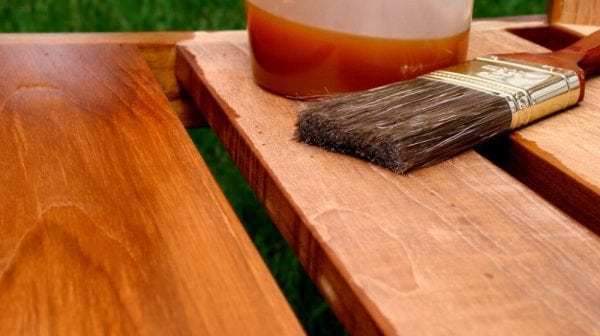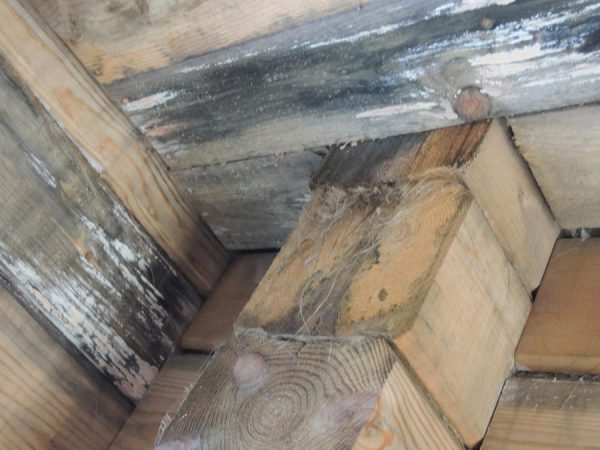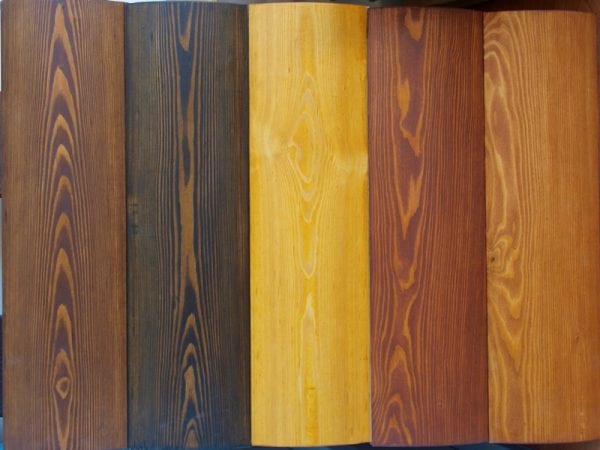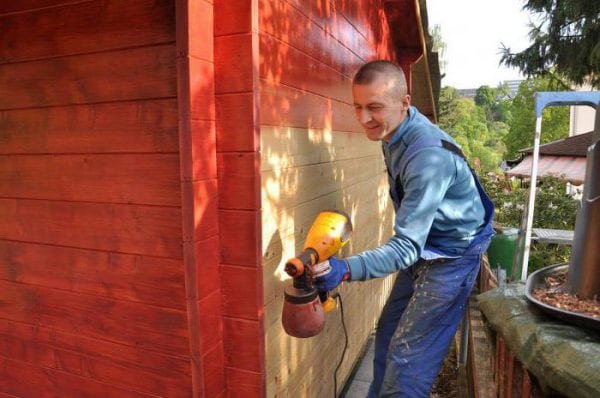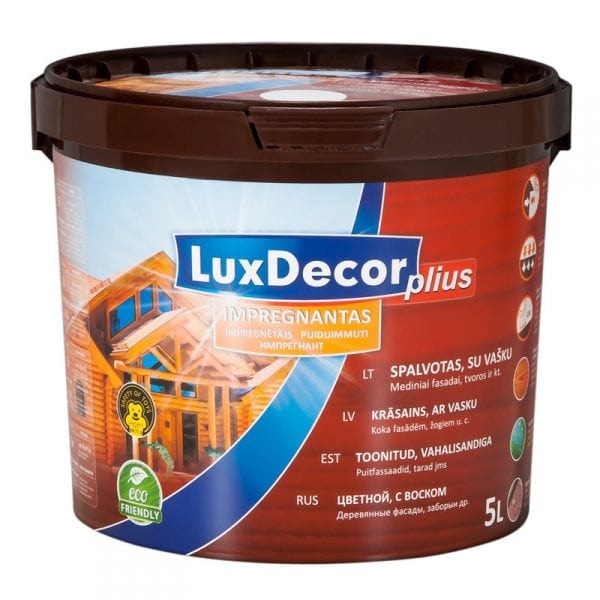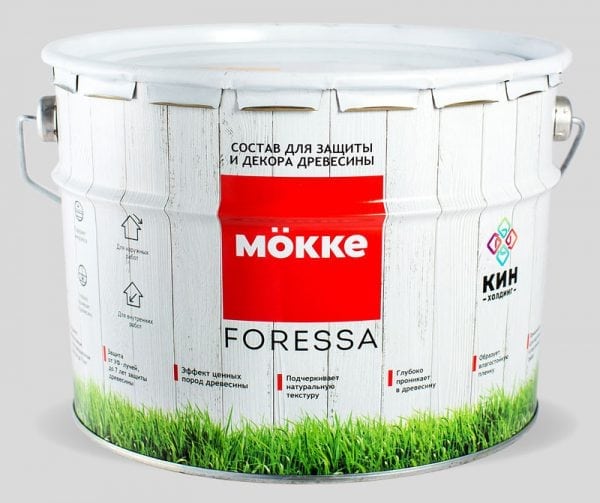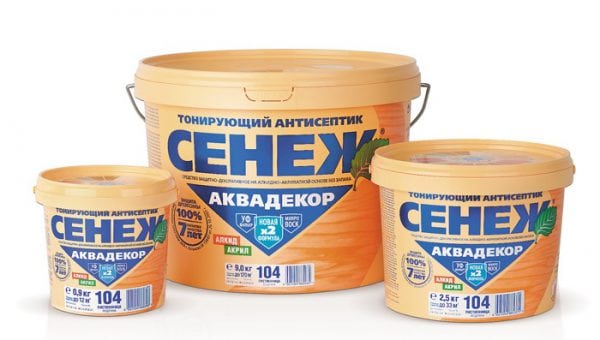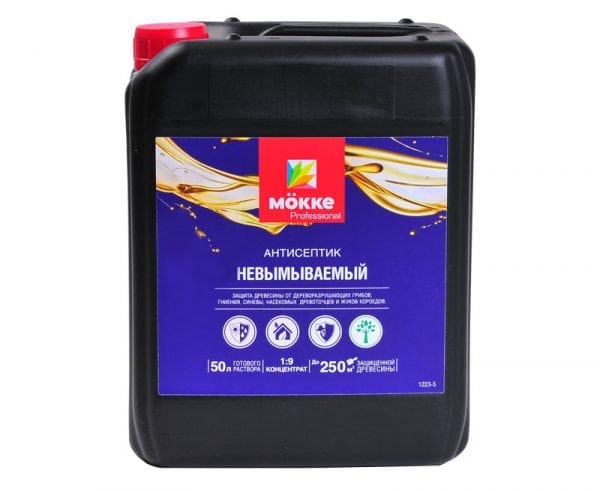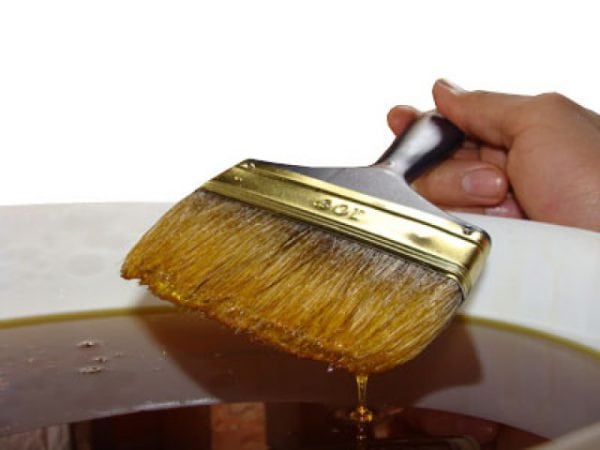Impregnation for wood, for work on the street is not a whim of the owner of a private log house or a house from a profiled beam. It protects it from the effects of moisture and wind, sunlight and wood bugs, rot, mold and even fire (flame retardant).
- Types of Impregnation
- Purpose of using impregnation for outdoor use
- Selection rules
- Manufacturers
- Do-it-yourself antiseptic
- Surface preparation for processing
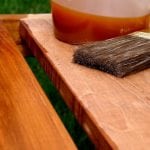
Important! In the variety of varnish coatings, paints can be found that include antiseptics and / or flame retardants, as well as substances that protect the wood from moisture. They are not cheap. Take a closer look at them. If you are faced with the task of not only protecting a wooden house, but also changing its appearance, such paints will be a good acquisition.
to contents ↑Types of Impregnation
If it is decided to use wood for construction and decoration, it is necessary to protect it from external aggressive factors - moisture (snow, rain), because rainfall impregnates the tree over time, causing it to deform and dry out. Without protection, the tree can rot, mold and fungus settle in it, which greatly reduces the service life and attractiveness.
For example, a white fungus destroys even the strongest board in a matter of months. Without protection, pests often settle in wooden structures, and besides, parasites can be brought already with the forest brought. The use of special tools will help reduce the risk of fire, making wood less combustible.
The lower part of the log house from moisture, fungus will protect the foundation, the base - their installation does not allow the tree to come into contact with the ground. Installing enough ventilation holes and ducts will reduce the risk of moisture accumulation. The upper part of the log house can be protected from these factors only by applying impregnations.
There are several types of outdoor wood preservatives. They can be divided into several large groups:
- penetrating (for internal work);
- film (for outdoor);
- antiseptics;
- flame retardants (prevent light inflammation);
- complex impregnations with both antiseptic and fire retardant properties.
Another unit - on the main substance:
- Water. Universal, suitable for both outdoor and indoor use, do not smell. They are a powder; a crystalline form can also be found on sale. Diluted with water according to the instructions. Dry for a long time, require preliminary treatment of the wood with sandpaper and wetting before application. Do not apply on dry wood.
- On solvents. They penetrate deeply into the structure of wood, smell sharply, and are toxic until they are completely dry. Ideal for external protection of the tree from moisture, mold, insects that have penetrated the upper layers. Apply only with a brush. Available in various colors.
- In oil. Classic stains, which are constantly used before. They penetrate deep into the tree, protecting it from moisture, and prevent cracking. On such surfaces, dirt and dust do not linger, washed off by the first rain. It can be applied with a brush or spray.
- Varnishes for outdoor use. A separate group of wood preservatives. Not only protect well from various atmospheric phenomena, but also give a beautiful appearance.
- AcrylicProtect the tree from blackening and bluing, insects and mold. Acrylic compounds impregnate wood - processed and unprocessed. They have a high decorative value, are available in various colors. Suitable not only for outdoor but also for indoor use. Dry for several hours.
- Wax or wax / oil impregnation. After their use, it is impossible to apply any other impregnation. Therefore, choosing this option, you need to think a few times.
Thus, penetrating compositions on various bases are preferred for outdoor use. It is worth mentioning tinting impregnations. In addition to protection against moisture, mold and mildew, they give the wood surface a beautiful color, emphasizing the texture of wood.
to contents ↑In addition to heat-resistant impregnating compounds, there are various typesfire retardant paints for wood.
Purpose of using impregnation for outdoor use
Most impregnations are intended to protect wood from damage and destruction, to improve decorative properties. The main types of impregnation and their purpose:
- Against darkening. The cause of the darker color of wood over time is the penetration of the fungus. High-quality impregnation will prevent fungus therefore, eliminate the darkening of the material. Different means protect wood for unequal time, which can vary from 3 months to several years. Usually, more expensive impregnations work for a long time, since they are practically not washed out of the base. Some tools simply mask the problem, while others act in a directional way, destroying microorganisms. Impregnation with chlorine is undesirable - the compounds burn and destroy the tree. Oxygen in solution works much better, without affecting the base and making the tree lighter.
- Against moisture, decay. Water repellent impregnation is suitable in almost any situation. The compounds penetrate the wood, preventing it from deforming, rotting, cracking. After applying the product, moisture will not penetrate into the deeper layers of the material, air exchange is optimized. Most products contain UV filters that prevent the material from fading, which only improves its performance. The impregnation layer will have to be renewed every 1 to 3 years or as indicated on the label.
- Against burning. Impregnations with bioprotection and fire protection “two in one” are no less popular. There are cover (varnishes, pastes that change color, but do not penetrate the structure) or in the form of compositions (impregnations that optimize the texture of the tree).
- For important, supporting bases. It is recommended that such means be used to cover load-bearing walls, other important elements that need to be more reliably protected from damage by fungus, insects, groundwater and sediments. These impregnations have the property not to be washed for years, supplemented by powerful antiseptic and fungicidal properties. More expensive products do not change color, and those that are cheaper can make the wood greenish.
There are decorative impregnations that are water-based and contain acrylates, do not allow the tree to change its tone, protect it from UV rays. The colors of the impregnations are varied, which allows you to change the primary color of the tree in accordance with the chosen style.
to contents ↑Selection rules
Compositions for protecting wood can be unidirectional and complex. The former protect against one thing: from moisture (water repellent) or from rot, mold, bugs (antiseptic), or prevent fire (flame retardant). The second ones act comprehensively in three directions: they do not allow decay, repel moisture, and prevent the tree from flaring up when accidentally in contact with a fire source.
Rules for the choice of impregnation:
- Decide what you need to protect the tree from. Complex impregnations are more expensive, but they save time and physical strength. Unidirectional compounds can be applied in turn, but you will have to spend three times more time and effort on this. Plus you need to remember that usually one layer is not enough.
- Think about how important the appearance of the tree (home) is for you.You may need compositions that can be tinted, or they are available in colors.
- Evaluate the scope of work in order to buy as much impregnation in the construction market as you need, do not forget about a small supply. This is especially important if the composition is tinted.
- Do not buy impregnation in the construction market. This is due not only to the possible lack of a product certificate from sellers, but also to inappropriate storage conditions. Impregnations should not be stored at subzero or too high temperatures.
- After choosing a tool, read the instructions for it. It always indicates how long the wood will be protected. Look only at the first digit. Any composition with color in direct sunlight will fade for 3 to 5 years. Therefore, it makes no sense to spend money on expensive products that promise color preservation for 10 years or more. This is nothing more than a marketing ploy and a price wrap.
- Do not forget to check with the seller how the impregnation is applied; perhaps the best solution would be to purchase an inexpensive airbrush. This and the composition will save a little, and will ensure smooth application without sagging.
to contents ↑Important! Always do work on a respirator. Even the safest environmentally friendly impregnations contain benzene. Inhaling it is harmful even in microscopic quantities. Especially harmful to humans are oil and alkyd compounds.
Manufacturers
The impregnation market is diverse. The compositions are produced both by domestic manufacturers and foreign. To have an idea, you need to get acquainted with the most famous brands:
- "LuxDecor Plus". A high-quality product of the European level - water-soluble wood impregnation LuxDecor Plus has appeared on the Russian market as an affordable way to deal with several aggressive weather factors at once. She is not afraid of wind, rain and snowfall, and it is these conditions that often harm wood. Impregnation also protects against rodents and fungus for a period of at least 3 years after treatment. It is possible to apply acrylic impregnation both outside and indoors, due to the absence of alkyd resins and solvents, it is completely safe for the environment and people living in the house. Suitable for decorating children's toys and furniture, odorless and contains wax in the composition. It has a gel consistency, which greatly facilitates application and also reduces processing time. It does not flow even when painting the ceiling and provides a matte silky layer (with two-layer application), which can reliably protect the wooden surface from rotting and mold for the specified operational period.
- "Mokke Foressa." Mokke Foressa alkyd resin wood protection and decoration composition enhances the resistance of the treated wood to UV rays, seasonal temperature changes, light mechanical damage, mold and insects. With a three-layer application, the surface treated with Mokke Foressa acquires the delicate sheen and decorative effect of expensive wood for up to seven years. Impregnation forms a moisture-resistant film due to the micro wax in the composition, which increases the water-repellent property of the tree (compared to the untreated surface). For interior and exterior use.
- "Belinka." Slovenian brand that produces penetrating protective primers, azure thick-layer impregnations with wax, decorative azure, deeply penetrating impregnations, colorless liquid antiseptics.
- "Pinotex". Netherlands company. It produces several varieties of wood preservatives, including yacht alkyd-urethane varnish with a high degree of wear resistance.
- Senezh. Domestic producer of NPO Drevozashchita. It produces all types of impregnations for wood and decking: antiseptics, bio-pyrenes, preservation solutions and protective compounds for thrifty owners. The range is tinted
- North. Also a domestic manufacturer. It produces professional wood preservatives that are in no way inferior to foreign ones. It produces bio-pyrenes, fire-retardant impregnations, antiseptics, not only for wood, but also for other types of substrates.
- "Dufa". German manufacturer.It produces several types of protective products for wood with and without wax, including colorless antiseptics that protect against mold, blue, and moisture.
- "Tikkurila". The Finnish concern, producing a great variety of coatings, including protective compounds for wood - the Valtti line. The antiseptic "Euro Eko Wood" from "Tikkurila" can be tinted in the desired color. It perfectly protects the tree on the street from mold, rot and moisture.
- "Aquatex". Domestic manufacturer. It produces several types of combined formulations (antiseptic + moisture protection + UV filter), biopiren protection is not presented. There are wax and oil based products (Aquatex Extra), decorative with protective functions (Aquatex), indelible antiseptic (Aquatex soil antiseptic).
- "Neomid". Russian manufacturer of the best fire protection for wood and decking. Means "Neomid 450" - a preservative, belongs to 1 (coating in 4 layers) and 2 class of effectiveness of protection against fire (GOST 53292-2009). The composition, in addition to flame retardants, includes an antiseptic and a tinting pigment to control the quality of processing. The antiseptic effect lasts up to 10 years, fire retardant - up to 7 years.
- “KSD” is a tool of the Russian company “Lovin”. It belongs to the class of preservatives and effectively protects wood on the street and indoors from decay and fire (protection class 2 according to GOST 53292-2009). There are no dyes in the composition, so you need to work very clearly, without missing a millimeter. "KSD" is able to stop the already begun process of decay, to destroy mold. Corrosion activity in contact with treated wood and metal is low. The composition does not smell, protects wood from fire for 4 years, from biological processes - 5 years. Belongs to one of the best wood preservatives.
- "MÖKKE antiseptic." The indelible MÖKKE antiseptic guarantees long-term protection of the tree against mold, mildew, insects and fire hazard. The latest wood protection product was created taking into account all the features of the changing Russian climate and using the latest Finnish technologies. This combination guarantees the buyer a high-quality preservative for wood protection for a period of more than 55 years at a price significantly lower than foreign analogues. The new generation antiseptic contains polymer dispersions, pigments, waxes and special additives, which together makes it possible to use it to protect terraces, foundations, arbors and any wooden structure and products, even in the case of prolonged contact of the treated surface with water and soil. The preparation of European quality can be used as a primary coating before painting with varnishes and paints, or perform an enhanced protective function in self-processing of wood. Suitable for application with a brush, roller or spray gun.
to contents ↑Advice! Before buying, look at the site of the selected manufacturer, study the range of impregnations and their properties, pay attention to the cost. Then make an estimate, having counted everything to the smallest detail. Only then go to the store for material.
Do-it-yourself antiseptic
There are many recipes for home-made mixtures that protect a tree from rotting and eating by wood-beetle bugs. The main proposed composition is bitumen mixed with kerosene. However, such protection is relevant only for buried wooden parts, for example, pillars for the fence or the lower corners of the log house. It is impossible to imagine a wooden house coated with such a hellish mixture in terms of appearance.
Wax-based wood impregnation not only does not spoil the appearance of wood and has good water-repellent properties, but also protects against annoying insects. Anyone will cope with its preparation:
- Prepare the ingredients - wax and turpentine, rosin can be added.The ratio of wax / turpentine - 2/1, wax, turpentine, rosin - 100/50/25.
- Heat the wax in a water bath, then remove from heat, add turpentine to it. Stir thoroughly until a smooth paste is obtained.
- The second option - heat the wax in a water bath, add rosin. After dissolving, carefully rub and add turpentine in a thin stream. If you want a pleasant smell, add lavender or peppermint oil.
Important! You can cover with such a composition railings, platbands, carved elements and the entire outer surface of the log house. Further painting can be done with oil coatings.
Both types of home-made impregnations have the following positive qualities:
- can be used not only for external work, but also for internal;
- have a pleasant persistent smell;
- have good resistance to mechanical damage;
- consist of environmentally friendly materials;
- repel water well, protect from rot, mold, insects;
- improve the appearance of the tree, make its texture clear;
- Do not peel off in the sun;
- dry quickly (no more than 7 hours).
Surface preparation for processing
Penetrating treatment requires clean, dust-free surfaces. If the tree was previously covered with varnishes, paints or other impregnations, the composition of which is unknown to you, you will have to completely clear the surface from them before applying the protective composition. Use various hard brushes, scrapers and a hot air gun for this, if it is not possible to remove the paint in other ways. Additionally sand the surface to make it smooth, then remove the dust.
Prepare the impregnation according to the instructions and apply it on the surface of the tree. Depending on the composition, each subsequent layer is applied either to a completely dried or still wet previous one. Impregnation without tinting after drying can be painted.
The tree must be protected from fire and atmospheric phenomena at the construction stage. Processing a finished house is quite difficult. It will not work to protect qualitatively all parts of a fully erected structure, which means that the risk of tree destruction from penetrating moisture and insects into unprotected places increases.

